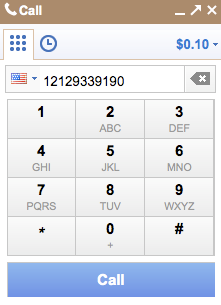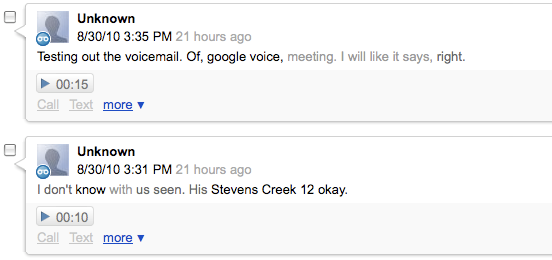When Google does anything, it’s big news. First it was Google Voice, then it was Google Wave, and last week it was the new Gmail upgrade that allows users to call out to the PSTN. Let’s quickly go over some of Google’s existing ‘voice chat’ tools.
Google Chat/Talk is probably more commonly known as the built-in IM client in Gmail. It allows voice and video chats but is limited to PC-to-PC only.
Google Voice is more or less a fancy call forwarding service. Each user is given a US phone number, and inbound calls to that number are then forwarded to other numbers owned by that user. Outbound calls can be placed by dialing the Google Voice number or by using the provided web interface.
Google’s newest move combines the two. Gmail users will have noticed by now the new “Call Phone” option sitting at the top of their contact lists. Clicking on it brings up a dialing menu, and if you’re already subscribed to Google Voice, your Google Voice number will be used for outbound calls. Your Google number can also be set to forward to your Gmail account so that you can take calls there as well. Additional features like free voicemail transcription and personalized greetings are also included.

I signed up for a Google Voice number to give this Gmail calling add-on a try. The sound quality isn’t half bad if you’re using a headset, and the added convenience of being able to call anyone I want when I’m browsing my e-mails is pretty neat. I’m also enjoying being able to listen to voicemails as they are left, and having the option of jumping into calls when I want to. For voicemail transcription, I would much rather go with Phonetag. Some of Google’s transcriptions are ridiculously inaccurate.
This is all pretty cool, but I’m not sure that it’s anything beyond that at this point. The service itself hasn’t really changed since Google Voice launched last year—I mean, calls to the US and Canada using Google Voice were always free, weren’t they? Bringing Voice functionality to Gmail seems to me just a move to get people like me who never bothered with Google Voice to actually try it. Mission accomplished, if that’s all they’re after.
Industry experts have been busy doing their usual speculating. Some say that Google is establishing the groundwork for their upcoming Facebook competitor by increasing engagement in their already existing social networking tools (Currently, you have to have your Gmail open to be able to take incoming calls forwarded from Google Voice). I’m not completely convinced here. First of all, the calling feature probably will not make me want to use Gmail more than I already do—it’s an added convenience that I might use every once in a while just because it’s there, and not really something that I see driving conversions. I’m not going to be on Gmail more to wait for incoming calls—I already have this thing called a phone. Secondly, Facebook has toyed around with the idea of introducing calling, and I’m pretty sure they dropped it. One-on-One calling is a bit too personal for most interactions that take place on a social networking site, which is probably why you haven’t heard much about the already existing Facebook calling applications.
Others say that this move by Google is a direct assault on Skype. While this may be true, the current product isn’t really a Skype killer and it kind of makes sense that it’s not all there yet. I could see how they might use Gmail, one of their more successful services, as a litmus test for new product offerings. On the flip side, I also probably wouldn’t read too much into the 1 million calls made in the first 24 hrs (Take into account how many Gmail users there are and the fact that I alone made like 10-15 test calls).
The last popular idea is that Google is really just after better advertising data. With more Google Voice users comes more voicemail (and maybe even conversation) transcriptions, which leads to more targeted ads. All I have to say to this is, good luck trying to make sense of some of these:


